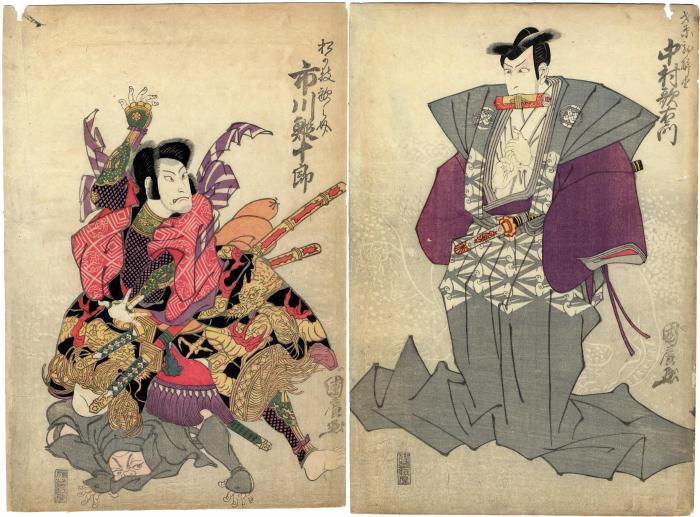Utagawa Kunihiro (歌川国広) (artist )
Nakamura Utaemon III (中村歌右衛門) as Saibara Kageyu (才原勘解由) on the right and Ichikawa Ebijūrō I (市川鰕十郎) as Matsugae Tekinosuke (松が枝敵之介) in the play Meiboku Sendai Hagi
1816
20.5 in x 15.25 in (Overall dimensions) Japanese woodblock print
Signed: Kunihiro ga (国廣画)
Publisher: Sōshiya (Marks U300 - seal 24-060)
Museum of Fine Arts, Boston - Ashisato diptych of the same performance - one exception: the rat is much smaller
Museum of Fine Arts, Boston - 1848 Hirosada diptych of this scene, but with a huge looming rat
Museum of Fine Arts, Boston - Hokushū 1816 tetraptych showing the same actors in the left-hand panels Utaemon is wearing a costume with his identifying mon, the tsuru-bishi (鶴菱) or cranes arranged in a lozenge motif. He holds his hands in a particular way, the yōjutsu (妖術) that allows him to perform astounding magical tricks.
****
Osaka Prints has given us an cogent summary of this play:
"Meiboku sendai hagi (Sandalwood and bush clover of Sendai: 伽羅先代萩) dramatized the intriques [sic] over succession within the Date clan of Sendai during the third quarter of the seventeenth century. It was performed in an alternate sekai ("world" or theatrical setting: 世界), set back in time during the Onin civil war under the Ashikaga shogunate of the fifteenth century (Ashikaga thus becomes a theatrical substitute for the Date clan name). It is a classic play, so popular that during the Edo period it had at least one performance nearly every year since its premiere in 1777. The fictionalized central story involved Lord Ashikaga Yorikane's forays into the pleasure quarter and his murder of the courtesan Takao (高尾). This episode is an amplification of an actual incident in which the twenty-one-year-old clan leader Date Tsunamune became the lover of the Yoshiwara courtesan Takao, causing a scandal that led to his downfall. Another story line involves Nikki Danjō (Yorikane's evil nephew), the orchestrator of a conspiracy to overthrow Yorikane. The intrigue failed, however, and Nikki was slain.
The giant ghostly rodent lurking behind the two protagonists [in a Hirosada diptych] is actually Nikki, who possess magical powers and can transform himself into a rat. He is a prime example of an important role type known as jitsuaku (or tategataki) — unrepentantly evil samurai who plot to overthrow their lords. They are also referred to as kuni kuzushi ("demolisher of nations") to signify their intention to usurp an emperor's throne or a daimyō's domain."
****
Click on this image to enlarge it
Then enlarge the right-hand panel and look closely at the faintly printed background behind the standing figure of Nikki Danjō (aka Saibara Kageyu). There you will see the spirit of the rat clearly delineated. Its backend is in the lower right and its head is in the area just to the left of the magician's right sleeve.
****
We have added a link above to a similar diptych by Ashisato (active from ca. 1800 to 1816). In both this example from the Lyon Collection and the one in Boston the actors are the same. If you look closely at both costumes you will see that there are common motifs even though at first glance their outfits seems considerably different.
****
Illustrated in Ikeda Bunko, Kamigata Yakusha-e Shusei, (Collected Kamigata Actor Prints) volume 2, Ikeda Bunko Library, Osaka, 1998, no. 4
This diptych commemorates a performance at the Kado Theater in the ninth month of 1816.
The fellow in the gray outfit being subdued on the left is meant to represent a giant rat. This is referred to as a nuigurumi (縫ぐるみ) or literally a 'sewn wrapping' which is used to portray animals on stage.
actor prints (yakusha-e - 役者絵) (genre)
magicians (mahōtsukai - 魔法使い) (genre)
Nakamura Utaemon III (三代目中村歌右衛門) (actor)
Ichikawa Ebijūrō I (初代市川鰕十郎 9/1815 to 7/1827) (actor)
Kyōto-Osaka prints (kamigata-e - 上方絵) (genre)
Sōshiya (草紙屋) (publisher)
Ashikaga Yorikane (足利頼兼) (role)
Kabuki (歌舞伎) theater terms (genre)
Meiboku Sendai Hagi (伽藍先代萩) (kabuki)
